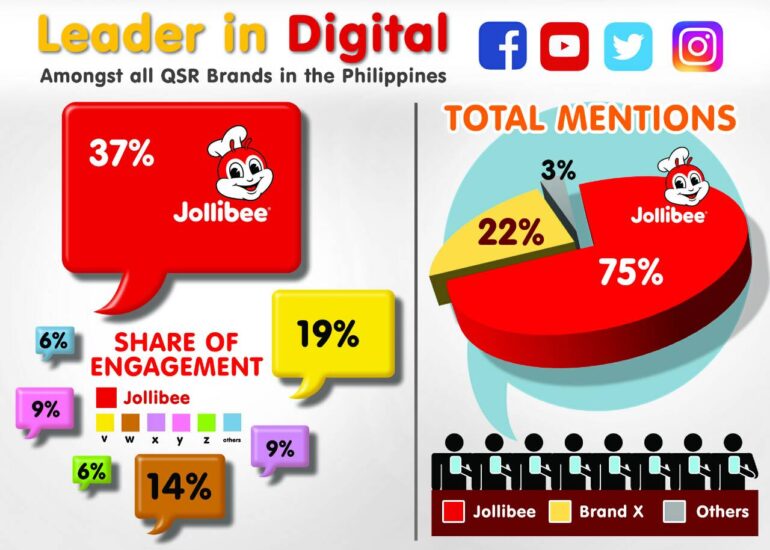Jollibee, the Philippines’ No.1 fast food chain, has been capturing the hearts of Filipinos with its signature, Langhap-Sarap meals. Lately, the brand has also been winning the hearts of millions online with a series of digital contents, each one a hit. If you’re a victim of the tear jerking videos of Jollibee recently like their #KwentingJollibee “Vow”, their heart touching videos is surely a hit in the industry.
According to Community Plus, a widely-used social media monitoring tool reports that from January to June 2017, Jollibee has managed to dominate the competition in the Quick Service Restaurant category (QSRs). This is particularly evident in Facebook, where it garnered a staggering 37% of engagement, twice that of its closest foreign competitor.
Another social media intelligence tool, Thoughtbuzz, also reports that Jollibee registered 1.5 Millon mentions across various digital platforms, making it the no. 1 most talked about QSR brand. That’s almost thrice the results from its competitors in the same period.
“Jollibee’s stellar digital success has been key to sustaining our market leadership in the country, across all our major target markets. Through world-class, highly engaging online content and digital innovations, we will continue to break the internet to reinforce our position as the Philippines’ most loved, most talked about brand. For us in Jollibee, capturing the hearts of the Filipinos online (and offline) is the ultimate reward.” – Francis Flores, Jollibee Global Brand Chief Marketing Officer and PH Marketing Head.
The Kwentong Jollibee Success
If you haven’t watched a single episode of Kwentong Jollibee, then you’ve missed out on something big. The brand’s original series has not only gone viral multiple times this year, but has also earned multiple accolades from global industry leaders.
The highly evocative “Vow”, “Date”, and “Crush” videos show during the valentine season, successfully captured the online audience with over 50 million views on Facebook and YouTube, about 1.3 million shares, 7.5 million in engagement, and 82 million reach (72% organic). The series also generated over PhP150 million in free PR and media values as well.
To other brands, reaching this certain number in an organic way is almost impossible. For Jollibee, they landed in a gold mine in how to touch more Filipinos with emotion. The viral success of the series continued during the mid-year with “Parangal” and “Powers” which are tributes to the sacrifices of moms and the heroic deeds of dads, for providing a comfortable life to their families.
Currently, this trend is still prominent to Jollibee and we think their momentum for this kind of format isn’t an “Another ordinary campaign”. As long as they keep their soft sell approach and the “hugot” of Filipinos, this formula is a sure digital viral campaign for the brand.
An Array of World-Class Content
Apart from its online ads, Jollibee has also produced successful online campaigns, such as the JolliDance showdown series with 29 million views on Facebook and YouTube, along with digital engagement innovations such as the Twitter Intercept, which suggests various Jollibee products depending on the topic and what part of the day it is.
The brand was also the first in the QSR industry to introduce an augmented reality experience called JolliDance Showdown app, which to date, has already registered 100,000 downloads.
It lets kids turn the Jolly Joy Box of their Jolly Kids Meal into into an interactive platform, and bring to life a dancing Jollibee, compose their own tunes, and personalize their avatars, leading to a unique augmented reality experience.
Together, these efforts have contributed to an astonishing share of engagement across the QSR market on the digital platform. As such, you can look forward to more exciting digital content from Jollibee in the coming months.
To stay updated with Jollibee’s new campaigns and products, you may follow their official accounts on Facebook, YouTube, Twitter, and Instagram.
Emman has been writing technical and feature articles since 2010. Prior to this, he became one of the instructors at Asia Pacific College in 2008, and eventually landed a job as Business Analyst and Technical Writer at Integrated Open Source Solutions for almost 3 years.




